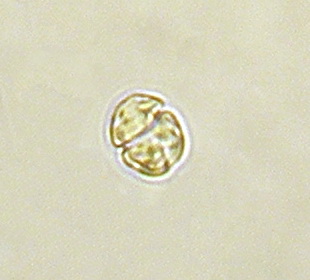Nongonococcal urethritis (NGU) is an inflammation of the urethra that is not caused by gonorrheal infection.
Mycoplasma hominis is a species of bacteria in the genus Mycoplasma. M. hominis has the ability to penetrate the interior of human cells. Along with ureaplasmas, mycoplasmas are the smallest free-living organisms known.

Cistus is a genus of flowering plants in the rockrose family Cistaceae, containing about 20 species. They are perennial shrubs found on dry or rocky soils throughout the Mediterranean region, from Morocco and Portugal through to the Middle East, and also on the Canary Islands.
Ureaplasma urealyticum is a bacterium belonging to the genus Ureaplasma and the family Mycoplasmataceae in the order Mycoplasmatales. This family consists of the genera Mycoplasma and Ureaplasma. Its type strain is T960.

Gymnodinium is a genus of dinoflagellates, a type of marine plankton. It is one of the few naked dinoflagellates, or species lacking armor. Since 2000, the species which had been considered to be part of Gymnodinium have been divided into several genera, based on the nature of the apical groove and partial LSU rDNA sequence data. Amphidinium was redefined later. Gymnodinium belong to red dinoflagellates that, in concentration, can cause red tides.

Pathogenic bacteria are bacteria that can cause disease. This article deals with human pathogenic bacteria. Although most bacteria are harmless or often beneficial, some are pathogenic, with the number of species estimated as fewer than a hundred that are seen to cause infectious diseases in humans. By contrast, several thousand species exist in the human digestive system.

Sexually transmitted infections (STI), also referred to as sexually transmitted diseases (STD), are infections that are commonly spread by sexual activity, especially vaginal intercourse, anal sex and oral sex. Many times STIs initially do not cause symptoms. This results in a greater risk of passing the disease on to others. Symptoms and signs of disease may include vaginal discharge, penile discharge, ulcers on or around the genitals, and pelvic pain. STIs can be transmitted to an infant before or during childbirth and may result in poor outcomes for the baby. Some STIs may cause problems with the ability to get pregnant.
Tenericutes is a phylum of bacteria that contains the class Mollicutes. The name was validated in 1984 as a new division (phylum). Notable genera include Mycoplasma, Spiroplasma, Ureaplasma, and Phytoplasma. Tenericutes species are part of normal, healthy placental microbiome.
Ureaplasma parvum is a species of Ureaplasma, a genus of bacteria belonging to the family Mycoplasmataceae.
Ureaplasma canigenitalium is a species of Ureaplasma, a genus of bacteria belonging to the family Mycoplasmataceae. It has been isolated from dogs. It possesses the sequence accession no. for the type strain: D78648.
Ureaplasma cati is a species of Ureaplasma, a genus of bacteria belonging to the family Mycoplasmataceae. It has been isolated from cats. Its sequence accession no. for the type strain: D78649.
Ureaplasma felinum is a species of Ureaplasma, a genus of bacteria belonging to the family Mycoplasmataceae. It has been isolated from cats. It possesses the sequence accession no. for the type strain: D78651.
Ureaplasma gallorale is a species of Ureaplasma, a genus of bacteria belonging to the family Mycoplasmataceae. It has been isolated from chickens and barnyardyard fowl. It possesses the sequence accession no. for the type strain: U62937.
Ureaplasma diversum is a species of Ureaplasma, a genus of bacteria belonging to the family Mycoplasmataceae. It possesses the sequence accession no. for the type strain: D78650.
Mycoplasma amphoriforme is a species of bacteria in the genus Mycoplasma. This genus of bacteria lacks a cell wall around their cell membrane. Without a cell wall, they are unaffected by many common antibiotics such as penicillin or other beta-lactam antibiotics that target cell wall synthesis. Mycoplasma are the smallest bacterial cells yet discovered, can survive without oxygen and are typically about 0. 1 µm in diameter.
Mycoplasma orale is a small bacterium found in the class Mollicutes. It belongs to the genus Mycoplasma, a well-known group of obligate intracellular parasites that inhabit humans. It also is known to be an opportunistic pathogen in immunocompromised humans. As with other Mycoplasma species, M. orale is not readily treated with many antibiotics due to its lack of a peptidoglycan cell wall. Therefore, this species is relevant to the medical field as physicians face the task of treating patients suffering from infections with this microbe. It is characterized by a small physical size, a small genome size, and a limited metabolism. It is also known to frequently contaminate laboratory experiments. This bacteria is very similar physiologically and morphologically to its sister species within the genus Mycoplasma; however, its recent discovery leaves many questions still unanswered about this microbe.
The exact role of Mycoplasma hominis in regards to a number of conditions related to pregnant women and their (unborn) offspring is controversial. This is mainly because many healthy adults have genitourinary colonization with Mycoplasma, published studies on pathogenicity have important design limitations and the organisms are very difficult to detect. The likelihood of colonization with M. hominis appears directly linked to the number of lifetime sexual partners Neonatal colonization does occur, but only through normal vaginal delivery. Caesarean section appears protective against colonization and is much less common. Neonatal colonization is transient.
Ureaplasma urealyticum is a species in the genus Ureaplasma that can cause infection. Though most bacteria possess a cell wall, U urealyticum does not. It is found in about 70% of sexually active humans. It can be found in cultures in cases of pelvic inflammatory disease and is transmitted through sexual activity or from mother to infant during birth. It is not a commensal of the healthy uterine or amniotic microbiome. Infection with U. realyticum can contribute neonatal infection and negative birth outcomes.




